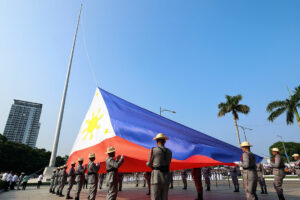




Quarterly Economic Growth Release: More BSP cuts to come
 DOWNLOAD
DOWNLOAD

Monthly Economic Update: Fed catches up
 DOWNLOAD
DOWNLOAD

Inflation Update: Steady and mellow
 DOWNLOAD
DOWNLOAD


FDI net inflows decline in August

Net inflows of foreign direct investment (FDI) into the Philippines slid in August mainly due to a sharp decline in investments in debt instruments, data from the central bank showed.
Net inflows dropped by 14.5% to USD 813 million in August from USD 951 million a year ago, the Bangko Sentral ng Pilipinas (BSP) reported on Monday.
Month on month, inflows dipped by 0.9% from USD 820 million in July.
 “The decline in FDI net inflows during the month was due mainly to the 21.6% contraction in nonresidents’ net investments in debt instruments,” the BSP said in a statement.
“The decline in FDI net inflows during the month was due mainly to the 21.6% contraction in nonresidents’ net investments in debt instruments,” the BSP said in a statement.
Net investments in debt instruments slumped by 21.6% to USD 529 million in August from USD 675 million in the same month a year ago.
These consisted mainly of intercompany borrowing or lending between foreign direct investors and their subsidiaries or affiliates in the Philippines, the central bank said.
“The remaining portion of net investments in debt instruments are investments made by nonresident subsidiaries/associates in their resident direct investors, i.e., reverse investment,” it added.
BSP data also showed a 9.4% decline in nonresidents’ reinvestment of earnings to USD 217 million from USD 240 million a year earlier.
On the other hand, investments in equity and investment fund shares inched up by 2.8% year on year to USD 284 million in August from USD 276 million.
Net investments in equity capital other than the reinvestment of earnings surged (83.6%) to USD 66 million in August from USD 36 million in the previous year.
Equity capital placements plunged by 52.5% to USD 103 million, while withdrawals slid by 79.8% to USD 36 million.
By source, the bulk of equity capital placements were from Japan (72%), followed by the United States (17%).
These were invested mainly in manufacturing (63%); real estate (20%); electricity, gas, steam and air-conditioning supply (9%).
Eight-month period
In the first eight months, FDI net inflows rose by 3.9% to USD 6.07 billion from USD 5.84 billion in the year-ago period.
Investments in equity and investment fund shares jumped by 26% to USD 2.2 billion from USD 1.75 billion.
Net foreign investments in equity capital surged by 59.4% to USD 1.34 billion in the January-August period.
Placements climbed by 38.8% to USD 1.7 billion and withdrawals slipped by 6.6% to USD 356 million.
These placements mainly came from the United Kingdom (45%), followed by Japan (36%) and the United States (8%).
Investments were mostly poured into manufacturing (75%), real estate (11%) and wholesale and retail trade (4%) industries.
Meanwhile, net investments in debt instruments went down by 5.5% to USD 3.86 billion from USD 4.09 billion. Reinvestment of earnings likewise decreased by 4.8% to USD 866 million.
Rizal Commercial Banking Corp. Chief Economist Michael L. Ricafort said the decline in FDIs can be attributed to the high interest rates, as the central bank only began its easing cycle in mid-August.
The Monetary Board cut rates for the first time in nearly four years at its Aug. 15 meeting, delivering a 25-basis-point (bp) rate cut. Since then, it has reduced borrowing costs by a total of 50 bps, bringing the key rate to 6%.
John Paolo R. Rivera, a senior research fellow at the Philippine Institute for Development Studies (PIDS), said global investors are more cautious amid uncertainty in the United States and European countries.
“High global interest rates and inflation concerns are also causing investors to take a conservative approach, reallocating capital toward safer, less volatile markets,” he added.
Mr. Rivera said the Philippines also continues to face structural challenges that make it difficult for investments to enter, such as “regulatory complexities, high operating and power costs, and persistence of infrastructure bottlenecks.”
“The relatively lower FDI could be brought about by a wait-and-see stance by some foreign investors while waiting for the CREATE MORE to be passed into law,” Mr. Ricafort said.
On Monday, President Ferdinand R. Marcos, Jr. signed into law the Corporate Recovery and Tax Incentives for Enterprises to Maximize Opportunities for Reinvigorating the Economy (CREATE MORE) Act. The law expands fiscal incentives and further cuts corporate income taxes.
“For the coming months, the CREATE MORE law would now make international investors more decisive to locate in the country with better incentives that could compete better with other Asian countries,” Mr. Ricafort said.
“Thus, there will be more FDIs into the country for the coming months due to CREATE more and also due to the expected further rate cuts by the Fed that could be matched by the BSP,” he added.
The Monetary Board is set to have its final policy meeting of the year on Dec. 19. BSP Governor Eli M. Remolona, Jr. has signaled the possibility of another 25-bp cut.
Meanwhile, Mr. Ricafort noted risk factors such as more protectionist policies by a Trump presidency starting in 2025 “would discourage some US companies from investing and creating more jobs outside the US.”
“However, offsetting risk factors for future FDI data would be possible more protectionist by a Trump presidency stating in 2025 that would discourage some US companies from investing and creating more jobs outside the US,” Mr. Ricafort added.
US President-elect Donald J. Trump is set to return to office in January. One of Mr. Trump’s main policy proposals are his stricter trade restrictions, including plans to slap a universal tariff as well as tariffs on Chinese goods.
The central bank expects to end this year with USD 10 billion in FDI net inflows. – Luisa Maria Jacinta C. Jocson, Reporter
This article originally appeared on bworldonline.com





 By BusinessWorld
By BusinessWorld